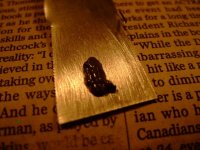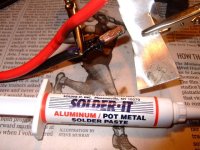I finally putting together a pack from my cellman A123 pouch cells purchased earlier this spring:
View attachment DSCF7542.JPG
Before risking the real cells I decided to practice soldering on some other aluminum pieces. Tried both thin alu sheets and household aluminum foil.
I sanded and applied "solder it" aluminum and pot metal paste:

Then soldered with a pen torch:

While the solder wetted the copper of the wire fine, it didn't stick to the aluminum at all. Here I used a hot flame and got a bit of burnt flux.
View attachment DSCF7547.JPG
Here I used a less hot flame and didn't burn the flux, but still no wetting of the aluminum:
What am I doing wrong??
I tried the same procedure with a soldering iron instead of the torch with exactly the same result: "Solder it" paste would stick fine to copper wire, but not to any of the aluminum pieces I tried on.
View attachment DSCF7542.JPG
Before risking the real cells I decided to practice soldering on some other aluminum pieces. Tried both thin alu sheets and household aluminum foil.
I sanded and applied "solder it" aluminum and pot metal paste:

Then soldered with a pen torch:

While the solder wetted the copper of the wire fine, it didn't stick to the aluminum at all. Here I used a hot flame and got a bit of burnt flux.
View attachment DSCF7547.JPG
Here I used a less hot flame and didn't burn the flux, but still no wetting of the aluminum:

What am I doing wrong??
I tried the same procedure with a soldering iron instead of the torch with exactly the same result: "Solder it" paste would stick fine to copper wire, but not to any of the aluminum pieces I tried on.

